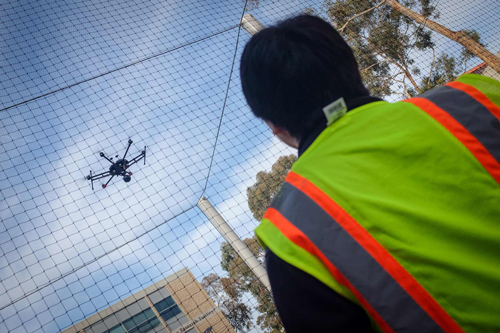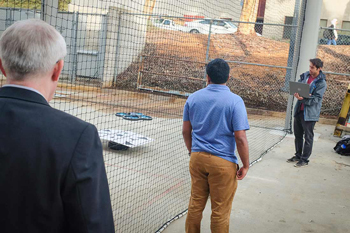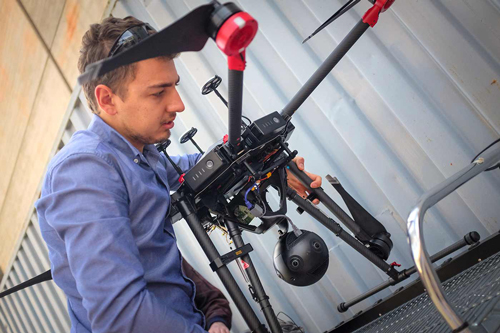Drone Research Takes Flight at UC San Diego

One drone landed on a moving Roomba-like robot while being guided by arm gestures. Another streamed a live, high-definition, 360-degree video feed as it flew overhead. These were some of the demos that helped inaugurate the first open-air aerodrome for unmanned aerial vehicles here on campus last week.
The aerodrome's inauguration was the first step in what engineers and scientists hope will be a new era for drone research at UC San Diego. One of their goals is to create a living laboratory for unmanned aerial vehicles by bringing together researchers from across campus, including computer scientists, structural, mechanical, aerospace, electrical and computer engineers and researchers from the Scripps Institution of Oceanography, the Qualcomm Institute and other institutes.

"We are bringing everyone together so that one plus one equals substantially more than two," said CSE professor Henrik I. Christensen, director of the Contextual Robotics Institute that oversees the new drone testbed. The facility is located next to the Powell Structures Lab, and it's made up of a 30-foot-tall mesh cage over a 2,500-square-foot outdoor area.
The facility will primarily be open to university research. Projects that could take flight in the new aerodrome include everything from quadcopters built by undergraduate students to balloons designed to monitor conditions inside hurricanes.
"We expect to see new research results on control of swarms of small UAVs and on the coordination between humans and robots," Christensen added. "We will also test entirely new vehicles for long endurance flights."
The aerodrome is opening not only in response to new University of California regulations governing the use of drones in residential areas but also in response to demand from researchers on campus. The testbed will be equipped with motion capture devices, which will allow researchers to test the quality of their flight control algorithms and will provide ground-truth data for all drones. A second phase will expand the testbed to an indoor 100-foot-tall area, connected to the outdoor testing cage. The expansion, which should take place next year, will result in a unique facility in the United States.

"The opening of the aerodrome is exciting because it enables drone research in a controlled environment, supporting experiments with a multitude of autonomous platforms and payloads as well as control, navigation, guidance and communications strategies," said Falko Kuester, a professor of Structural Engineering and faculty-affiliate in CSE, who also leads the Drone Lab in the Qualcomm Institute.
Kuester and his team are using drones to assess damage after natural disasters -- both real and simulated. They have developed drone-based imaging techniques to map full-scale buildings before, during and after earthquakes and fires. They subsequently tested these on the world's largest outdoor shake table (located at UC San Diego). The drones acquired images and videos of a six-story building to document damage as a simulated earthquake and then a staged fire unfolded. Powerful algorithms then turned the data the drones collected into detailed 3D models that researchers could literally walk through in a Holodeck-type environment to look for damage.
"The ability to develop, test and refine drone-based imaging techniques is critical for our rapid response team," said Kuester, who also leads the Cultural Heritage Engineering Initiative (CHEI) in the Qualcomm Institute. The CHEI team deploys around the world to assist with post-disaster reconnaissance and data collection, as well as the study and preservation of sensitive world heritage sites and ecosystems. They traveled to Puerto Rico after Hurricane Maria and to Mexico after a series of earthquakes hit the country in September.
"Being able to develop and test indoor-outdoor flight transitions, under the broad range of scenarios that can be created within the aerodrome is a game changer for us and will ultimately help with saving lives, following disasters," said CSE faculty-affiliate Kuester.
"There is today a shortage of engineers that have experience with drone technologies," Christensen said. "The aerodrome will allow us to fill that gap."
Read the full story on the Jacobs School of Engineering website.
Media Contacts
Ioana Patringenaru, ipatrin@ucsd.edu

